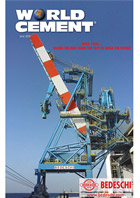Editorial comment
As we were preparing this issue for press, there came news of an explosion at a cement plant that left three people dead and two severely injured. At the time of writing, the available news was limited and it is not entirely clear what happened – but what comes across very clearly is the devastation felt by all concerned at this terrible loss of life.
Register for free »
Get started now for absolutely FREE, no credit card required.
Accidents happen more often than any of us would like. In the US alone, the Mine Safety and Health Administration (MSHA) has reported 10 deaths so far this year – 4 in the coal sector and 6 in metal/nonmetal mines. The causes range from falls to machinery failures. None of these accidents occurred in cement plants, but they so easily could have. A quick search reveals a number of tragic accidents in cement plants around the world in recent months, with fatal consequences. The cement manufacturing process is hazardous – that’s why companies put so much focus on health and safety. Heavy machinery, extreme temperatures and working at height are just a few of the most obvious dangers, and a hard hat and steel-toed boots can only do so much to protect you. In this environment, it is impossible to eliminate risk. All you can do is try to minimise it and in the meantime prepare your workforce to react to risk appropriately.
So how do you react to risk? Survival is supposed to be one of the basic human instincts, but all of us put ourselves in harm’s way on a regular basis, taking unnecessary risks because we are rushing or because we have become complacent, or simply because we’re not paying attention. Companies talk about making health and safety a core behaviour, so that it is a value akin to respect or honesty, but at the centre of this is recognising the risks that are present in every situation. That’s what safe behaviour comes down to – perceiving hazards.
The cause of this latest explosion will no doubt be fully investigated and the company will take all possible steps to ensure that such an accident never happens again. What would be really useful would be if they saw fit to share this information with the global cement industry, so that we could all recognise this hazard and prepare ourselves to react appropriately in our own facilities. The same goes for all those other accidents that showed up on my brief internet search, and those that didn’t make it as far as the media – those lost time injuries or near misses that left people at the plant pondering their own mortality. Admitting to failures is its own kind of risk, but sharing learning experiences is what World Cement is for.
In this issue, India’s UltraTech Cement reports on the measures taken to improve its own health and safety response, following guidance from DuPont Sustainability Solutions (page 27). You will also find mention of health and safety in this month’s World Cement plant tour, focused on Cemex UK’s Rugby cement plant (page 36). If you are interested in sharing your stories, email me at katherine.guenioui@worldcement.com.


